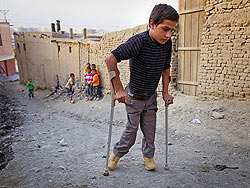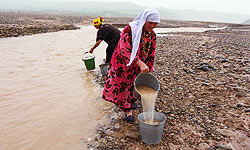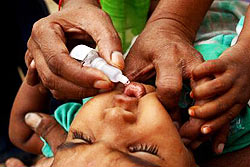Virus or poisoned drinking water?
An Examination of the Tajik Poliomyelitis "Epidemic" (A Summary)

The official position regarding infantile paralysis (polio) epidemics is that they are caused by the polio virus. However, several scientists, who have provided plenty of evidence pointing in the direction of mass poisoning, are questioning this theory. In its own study, Nebáncsvirág Association examines the background of the 2010 "epidemic" in Tajikistan, in the light of the above alternative explanation: is it possible that the disease was not caused by the virus, but by industrial and agricultural contamination?
 The 2010 Tajikistan Poliomyelitis "epidemic" caused a media stir, as Tajikistan belongs to the European Region of the World Health Organisation (WHO), which – supposedly owing to vaccinations – has been free of Poliomyelitis for almost a decade. During the course of the year, 579 cases of acute flaccid paralysis (AFP) were reported, and in three-quarters of the cases the presence of the polio virus was confirmed.
The 2010 Tajikistan Poliomyelitis "epidemic" caused a media stir, as Tajikistan belongs to the European Region of the World Health Organisation (WHO), which – supposedly owing to vaccinations – has been free of Poliomyelitis for almost a decade. During the course of the year, 579 cases of acute flaccid paralysis (AFP) were reported, and in three-quarters of the cases the presence of the polio virus was confirmed.
WHO came to a disappointing conclusion when examining the vaccination history of the patients. Each of the eighty-seven patients with a traceable vaccination history had received oral polio vaccination previously (Sabin vaccine). Seventy-six, that is, 87.35% received three or more doses, and eleven (12.64%) received fewer than three doses. Considering that a large proportion of the patients were children under 5, and therefore there could not have been a long time before they received the last vaccination, this proportion is of concern.
Since they had undergone multiple immunisation, how could they become paralysed?
The debate
Poliomyelitis (polio), that is infantile paralysis = an AFP, where polio virus is found in the patient's stool.
non-polio AFP = an AFP, where polio virus is not found in the patient's stool.
To this day it has not been proven indisputably that Poliomyelitis is a disease caused by a virus, and therefore it could be prevented by the use vaccination.
While the polio virus is easily spread, only 6% of those infected will become ill, and only 1% of those who become ill will be temporarily or permanently paralysed. In the meanwhile, there are several other diseases which produce identical symptoms and pathology to poliomyelitis, where the presence of the polio virus is unconfirmed. These diseases are called non-polio AFP, i.e. acute flaccid paralysis which is not caused by the polio virus.
Ralph R. Scobey, infantile paralysis researcher, has already pointed out in the 1950s that the cause behind all cases of AFP might actually be agricultural and industrial pollution, and any viral infections that might occur would be the consequences of this, as the virus would be attacking the already weakened tissues. His theory is supported by many experimental and everyday observations: certain pesticides and metals have long been known to cause paralysis. Furthermore, polio epidemics have only been known since the end of the 19th century, when the first persistent pesticides, such as the infamous DDT, appeared on the market. The fact that many patients' recovery was aided by heavy metal extracting agents also supports his theory.

Industrial and Agricultural Pollution
A number of experiments have proven that certain metals - primarily lead, tin, arsenic, aluminium, and mercury - cause poliomyelitis-like symptoms when they are accumulated in the body. These symptoms include diarrhoea, ailment of the cerebrum, general muscle paralysis, but primarily paralysis of the legs, and respiratory paralysis.
Pesticides which inhibit the acetyl-cholinesterase enzyme are especially dangerous to human health. They cause the nerve cells to stop communicating with each other, neural coordination is damaged and the following symptoms occur: shaking, nausea, weakness, or even paralysis and death.
These toxins generically pose a higher risk to children because of their smaller body size, different metabolism, their fast growing, developing organs, and because of their rudimentary blood-brain barrier. This might explain why most victims of polio "epidemics" are children under 5.
What is the situation like in Tajikistan?

In general, pesticides are used in an irresponsible way in Tajikistan. The result of the strained pace of cotton production in the Soviet era is that a high concentration of toxins can still be detected in the soil to this day. As a consequence of current illegal trade in these chemicals, the environment continues to be polluted with pesticides rated "highly dangerous" by the WHO.
If we take a look at the epidemiological map, it can be clearly seen that the highest number of paralyses occurred around the town of Kurganteppa. Kurganteppa is the centre of Tajik cotton production. It lies in the Vakhsh Valley, where the highest pesticide concentration was measured in the soil in the whole country: 48 kilograms per hectare. Furthermore, the largest pesticide dump in Tajikistan is located near the town. In the Soviet era, around 7500 tons of withdrawn or expired hazardous chemicals were buried here. This landfill is unmarked and unenclosed, it is washed by rain and windblown, which means that nothing stops the waste from polluting the soil and the air. And the locals are free to enter and dig up the containers for their own use, or in order to sell them.
The maintenance of pesticide storage facilities is similarly haphazard. Many of these are dilapidated, and some of them are also used as residential buildings. Rainwater trickling from the direction of these facilities often kills cattle by poisoning them. Most of the paralysis cases that occurred in industrial areas took place in the areas around the Takob and Tursunzade metallurgical plants, and on the lower sections of the rivers which pass by them. In Takob, situated North of the capital, lead and zinc are regularly let into the Varzob River. The Tursunzade aluminium plant is perhaps the largest in the world and it pollutes its environment mostly with fluoride. (This does not cause paralysis.) However, it can be stated that the Tajik metal processing industry leaves their sludge untreated, in general, and stores it in reservoirs, not complying with international regulations. These reservoirs contain mercury, antimony, aluminium, and lead. They pose a danger to the purity of air, soil, underground waters and surface waters, especially in extreme weather conditions.
Another common problem is the storage of used or expired strip lights containing mercury, which are dumped in illegal sites or ordinary rubbish dumps in cities. The discarded mercury strip lights pose such a high risk that the Asian Development Bank lists them amongst the most dangerous toxic waste in Tajikistan.
Direct cause
The above detailed sources of danger pose a constant threat of chronic poisoning to the population of Tajikistan. However, they could not have caused the temporary or permanent paralysis of nearly 600 people by themselves in the space of a mere few months. That could only have been acute (one-off, high dose) poisoning.
The direct cause was most likely the series of heavy rainfall between April and June 2010, which led to mudslides, landslides, and floods in the country's South-West. This has been the worst disaster in the region for over a decade. At least 40 people lost their lives, the roads became impassable, bridges collapsed, water pipes were damaged, the food reserves and growing seeds perished, and about 5,000 acres of agricultural land was flooded. And the possible cause of the "epidemic": about 70 thousand people remained without safe drinking water.
The most detailed reports of the events came from the city of Kulob. The number of paralysis cases were not especially high here, but this region was the worst hit by the floods, and this is the poorest region of Tajikistan, and of all the post-Soviet states. Half a kilometre of water pipes were destroyed, which meant that the 100 thousand residents of the city remained without regular access to safe drinking water for over a month. Two and a half weeks after the disaster began, a humanitarian news website reports that the city of Kulob is on the verge of an epidemiological crisis. In the middle of June they report simultaneously about the repaired water pipes, and a spectacular drop in the number of AFP cases. In the critical period, the population was most likely forced to drink settled river water, which contained heavy metals and pesticides residues stirred up from the riverbed mud.
The connection between the rains and the disease can be clearly seen on the chart and the map. (pics. 2-3). The number of paralysis cases suddenly went up at the end of March, at the start of the heavy rainfalls. The polio cases peaked in the middle of May, and after the weather normalised at the end of May, the number of new cases of paralysis fell back to normal. According to the map, the centres of the epidemic were the more densely populated counties situated by the polluted rivers, which suffered in the floods.
https://nebancs.hu/polio-gyermekbenulas/virus-or-poisoned-drinking-water.html#sigProGalleriae460a2d641
Lead poisoning from the Takob foundry
https://nebancs.hu/polio-gyermekbenulas/virus-or-poisoned-drinking-water.html#sigProGalleria7f9aa87a63
Processing the data from an April 2010 report clearly shows that a vast majority of cases happened along the Varzob and Kafirnigan rivers. These patients were registered to display the following symptoms: mainly diarrhoea and limb paralysis, fewer numbers of respiratory paralysis and facial nerve paralysis, or a combination of all of the above.
Takob lies at the upper section of the Varzob River. As we have seen, zinc and lead are regularly let into the river from the Takob metallurgy plant. We know that industrial reservoirs and rubbish dumps are unenclosed and uninsulated, so it is likely that during the heavy rainfalls these metals entered the river water in much higher quantities than usual, through the consumption of which they entered the systems of the local inhabitants.
The above listed symptoms seem to support this theory, as the consequences of lead poisoning are generally diarrhoea, and, in more severe case, ailment of the cerebrum (while it is not listed in the report, it is a typical AFP symptom), and limb paralysis, but there have been reports of facial nerve paralysis and respiratory paralysis, too. So all of the reported symptoms could suggest lead poisoning.
Interestingly, the map shows that in areas of flooding where pollution was not as significant, the number of "polio" cases was infinitesimal. This is most surprising in the Kulob area, as this was the region worst affected by the heavy rainfalls, it is a relatively densely populated area (Kulob is the fourth largest city in Tajikistan), and also the poorest. Despite all of the above, not only the April map, but the summary map also shows a relatively small number of cases.
Unexplained facial nerve paralysis and AFP
Interestingly, facial nerve paralysis was amongst the symptoms. It is important to know that according to the definition of poliomyelitis, the paralysis may only spread to the limbs and the chest muscles. When the face is paralysed, poliomyelitis is not suspected, and these cases do not have to be reported. This is rather strange, considering that according to a study by the John Hopkins University, facial nerve paralysis may be caused by the polio virus, and it could also be a symptom of Guillain-Barré syndrome, and as such, it should be counted as AFP.
The WHO mentioned 712 cases of paralysis in Tajikistan in February 2011, while current statistics only include 579 cases. If they discounted the cases where "only" the face was paralysed, we have an estimate of a total of 19% of the patients having facial paralysis during the "epidemic", which is too high a number for this to be a mere coincident.
The American health authorities have noticed decades ago, that there is a surprisingly high number of facial paralysis cases besides AFPs. They supposed that the bacterium causing Lyme disease was behind this. However, this would have been impossible in Tajikistan, as they never registered Lyme disease in the whole history of the country.
https://nebancs.hu/polio-gyermekbenulas/virus-or-poisoned-drinking-water.html#sigProGalleria0f4af5a89a
Arguments and counter arguments
While the media was conspicuously silent about the concurrence of the "epidemic" and the floods, the official position could argue that excrement contaminated with polio and other paralysis causing viruses washed into the the drinking water might have caused the disease on mass. But there is no evidence supporting this. And they do not try using this as an argument.
It is questionable whether a virus spread by excrement contaminated drinking water is able to infect such a large area in such a short space of time?
Furthermore, how is it possible that in areas where the presence of toxins was negligible, the polio virus did not spread despite floods and inadequate drinking supply?
Would it not be logical to consider that all cases of paralysis might have been caused by industrial and agricultural pollution, and that the presence or non presence of viruses are irrelevant?
In order to discard this alternative explanation completely and beyond doubt, a systematic investigation would need to be carried out as to whether the possibility of mass poisoning could be excluded, and as to why only 6% of those infected with polio do get ill.
We have no knowledge of any reliable investigations carried out by WHO or another organisation which could settle this debate: (1) What is the pesticide residue and heavy metal content in the AFP patients' blood and tissues, and by comparison that of healthy people's samples? (2) In both cases, what viruses related to paralysis are found in their stool?
As long as no such investigation is carried out, WHO and other health authorities act in an unscientific manner when they disregard the arguments of Scobey and others without giving a reasonable explanation, as they have done so for half a century. Moreover, they act irresponsibly towards millions of people, since they stop sick children from learning that heavy metal extracting agents might help recovery, and they make ethically disputable recommendations to the governments of developing countries so that they burden their limited budgets with the purchase of ineffective vaccines.
Why do we vaccinate against poliomyelitis?
 As we have seen above, all of the Tajik polio patients with a traceable vaccination history had been given the polio vaccine, and 90% of them received three or more polio vaccinations. Even though most of the paralysed patients were children under 5. This means that the vaccination failed to protect them from the disease.
As we have seen above, all of the Tajik polio patients with a traceable vaccination history had been given the polio vaccine, and 90% of them received three or more polio vaccinations. Even though most of the paralysed patients were children under 5. This means that the vaccination failed to protect them from the disease.
Official bodies are confounded by this data, since according to the Tajik Ministry of Health, the population's vaccination was higher than the required level.They explain themselves by the use of complicated sentences like this: "Due to a decrease in sanitation and access to clean water in the southwestern regions with heavy continued flooding, environmental exposure to vectors of polio may have increased the incidence of Poliomyelitis beyond the expected levels."
That is, we can never be vaccinated enough.
The WHO were certainly surprised, since the following sentence appears in their June 2010 report: "Investigation was under way to confirm the accuracy of reported immunization status." However, it seems that the results of the investigation were not very encouraging, as no corrections were published. At the same time, from this point forth, the above immunisation data has never been published again, as if WHO suspected a scandal.
The point is that WHO has not been able to offer any explanation as to the ineffectiveness of the vaccinations.
Despite all these contradictions, the importance of the polio vaccination is proclaimed everywhere, and they claim that the numbers of new cases of paralysis went back to normal following the six(!) new rounds of vaccinations prescribed soon after the "epidemic" broke out in Tajikistan.
And as to the profit of manufactures of vaccinations, on top of the six rounds of immunisation in Tajikistan, many of the neighbouring countries also stocked up on the Sabin vaccine, since, as a safety measure, Russia, Uzbekistan, Kyrgyzstan, Turkmenistan, Kazakhstan, and Afghanistan ordered the vaccination of the population.
Even though Tajikistan is one of the richest countries in natural water, it is very difficult to access safe drinking water in the country in general. According to a 2005 report, only 59% of the population drinks clean water.
Diseases spread by polluted drinking water pose a serious danger to the population. Typhus, dysentery, intestinal infections, and hepatitis are common, and this contributes to the preservation and deepening of rural poverty.
Almost a quarter of the water supply system is out of order, half of it does not comply with standards of hygiene, and because of blackouts, they generally operate periodically with constant shut-downs (in the winter period only for 2 hours a day), which means that practically nowhere can guarantee safe drinking water permanently.
Many settlements have no piped water at all. These began delivering drinking water by trucks, but the poorer ones resort to using water from shallow hand-dug wells, small lakes, springs, and rivers.
Has the number of polio infections increased or decreased worldwide?
An examination of data from several countries leads to the conclusion that the number of paralysis cases is fairly stagnant in developed countries, while it is on the increase in developing countries. (Remember: the statistics exclude paralysis of the face!)
It is very misleading when the term "infantile paralysis" is used to mean poliomyelitis or polio. On the basis of the original meaning of the expression, it should be used to mean AFP. These various names for the illness help to confuse people. When WHO make announcements about wiping out the polio virus, we are inclined to understand that they are proposing to get rid of infantile paralysis. Whereas WHO are fighting a battle against a virus which might not even cause paralysis. They remain silent about AFP. Whereas looking at the numbers of AFP cases, it is clear that paralysis is not about to disappear, on the contrary, there are more and more victims to it worldwide.
The only question is whether it would be more rewarding to spend the vast amounts spent on seemingly ineffective polio vaccination on the management of hazardous waste, and on the improvement and expansion of the sewage system in Tajikistan. This would, at least, prevent many contagious diseases, which emerge in one generation after another, and which are spread through drinking water, such as a typhus, dysentery, intestinal infections, and hepatitis.
Summary and recommendations
We find the work carried out by the health authorities regarding the investigation of the causes of the paralysis and the publishing of the results superficial. A full examination of all AFP patients would be necessary, including tests for viruses, and testing the levels of industrial and agricultural toxins in their blood. The truth can only be found out by doing the same tests on a healthy control group, and comparing the results. This is an urgent task, as in the past 15 years, the number of AFP cases has gone up by 700% worldwide.
While the virus theory cannot be scientifically defended against the theory of poisoning, WHO's worldwide campaign against polio seems to be a measure to keep up appearances and a waste of money, and the administering of polio vaccination raises ethical questions.







not the random misinformation that is at the other
blogs. Appreciate your sharing this best doc.
in the beam. This way you are going to avoid committing a very
common error that guitar players make as they first start
employing this technique. And who may have long lived the high life of the star athlete, in a
position to walk into any room, anywhere, and still have his choice of adoring women star struck at the
possibility of spending seconds with this bigger than life hero.
This sounds simple and may be; however, don't belong to the trap many novices do and stunt your power potential.
Article Source: contracting for shredding services from J&K Shredding, you could expect the highest
standards of quality and excellence.
author. I will remember to bookmark your blog and will often come back at some point.
I want to encourage continue your great work, have a nice afternoon!
and actual effort to generate a very good article… but what can I say… I
procrastinate a whole lot and don't manage to get nearly anything done.
really found you by error, while I was looking on Yahoo for something else,
Nonetheless I am here now and would just like to say kudos for
a fantastic post and a all round interesting blog (I
also love the theme/design), I don't have time to browse it all at the minute but I have book-marked it and also added
in your RSS feeds, so when I have time I will be back
to read much more, Please do keep up the great job.
We cannot update the Janine Roberts articles because the links you have sent are invalid.
Why give poliovirus any relevancy? It cannot be claimed causative as it has never actually been isolated (a requirement for proof). See harpub.co.cc/.../...
Janine Roberts, a source you use, is notoriously inaccurate: See plag.co.cc/jr/jr_te04p46.htm
Why give poliovirus any relevancy? It cannot be claimed causative as it has never actually been isolated (a requirement for proof). See Jim West's website "harpub".
Janine Roberts, a source you use, is notoriously inaccurate: Search for "jr_te04p46".